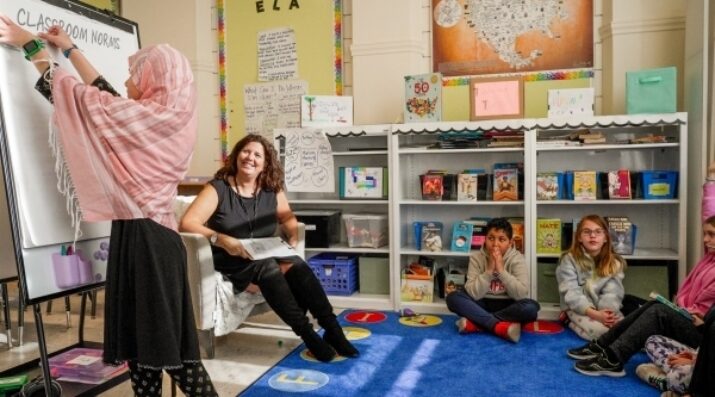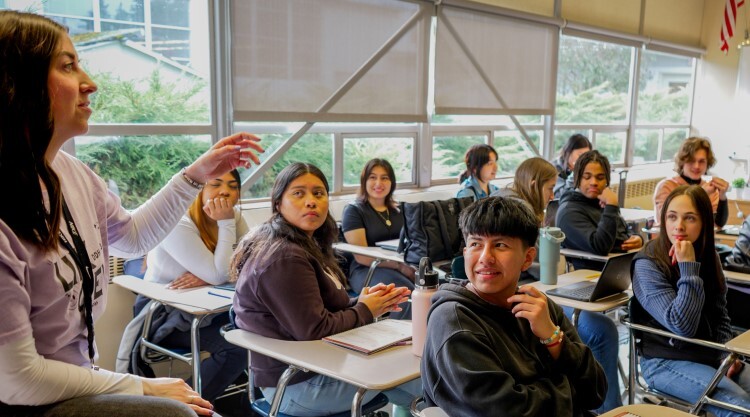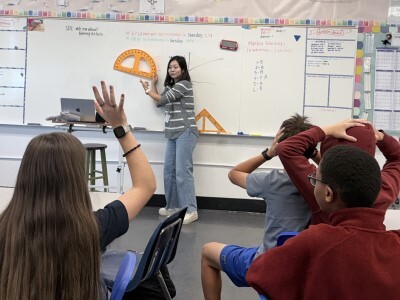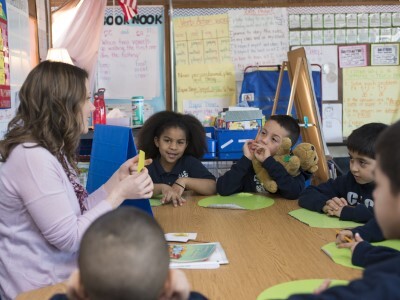Co-Creating Classroom Norms for an Inclusive School Climate
Topics

We’ve all had the experience of truly purposeful, authentic learning and know how valuable it is. Educators are taking the best of what we know about learning, student support, effective instruction, and interpersonal skill-building to completely reimagine schools so that students experience that kind of purposeful learning all day, every day.
Establishing classroom norms with students fosters belonging, agency, and shared ownership of the learning environment.
The first weeks of school set the tone for everything that follows. Students decide within the first weeks of school whether they feel safe and respected, and these feelings can profoundly impact their engagement and performance in the classroom. That’s why Wayfinder encourages and supports educators to begin each year by co-creating classroom norms with their students—from the earliest grades through high school, all students can benefit from the process and its impact on the classroom community.
This intentional practice isn’t just about behavior—it’s about building a foundation for trust, belonging, and shared responsibility.
As a classroom teacher, I saw firsthand how students became more engaged and felt more comfortable when they had a voice in shaping our class norms. By creating those norms together, rather than me handing out rules, our classroom felt more cohesive, and students took ownership in upholding the expectations they helped create. Now, as a curriculum designer and coordinator, I make sure to support teachers to engage their students in classroom co-creation to start every year off on the right foot.
Research shows that when students play an active role in shaping their learning environment, they’re more likely to retain new information, build critical thinking and interpersonal skills, and engage more readily and deeply in learning. The beginning of the year is a crucial window to establish this kind of student-centered culture.

Why Choose Classroom Norms Instead of Rules?
Shifting from top-down rules to co-created classroom norms can powerfully impact your students' experience and behavior. While rules are typically imposed and enforced by the teacher and other adults on campus, norms are built together, creating a sense of shared responsibility, student voice, and a stronger classroom culture. Here’s why classroom norms are often more effective:
1. Creating Norms Together Builds Belonging
When students help define how the class will function, they feel seen and heard from the start of the year. That collaboration sends a clear message: you matter here. This sense of belonging is more than just a nice feeling; it’s essential to learning. Research shows that feeling valued and connected at school increases engagement, academic motivation, and resilience.
2. Students Take More Ownership When They're Involved
When students contribute to setting expectations, they’re more likely to take responsibility for following them. These aren’t arbitrary rules handed down; they’re shared agreements the group has created together and committed to. They encourage student responsibility and personal investment, and they enable students to voice their needs.
3. Norms Reflect Student Voice and Agency
Every classroom is different, and students bring their own histories, needs, and ideas. Co-creating norms allows them to shape the environment in a way that works for them. This practice supports student agency, one of the Wayfinder Core Skills, as well as student growth and development.
4. Students Follow Norms They Help Create
Because co-created norms feel fair and reflect the group’s values, students are more likely to internalize and uphold them. This sense of fairness is critical in building a respectful classroom environment.
5. Norms Help Shape a Positive and Supportive Culture
A strong classroom community, bolstered by norms and effective classroom management, is linked to improved academic outcomes and fewer disciplinary incidents. Establishing norms isn’t just about managing behavior; it’s about creating a culture of trust and support. When students name how they want to treat each other, they become caretakers of that shared space. This proactive approach builds trust and reduces conflict before it starts.
How to Begin Co-Creating Classroom Norms
Co-creating norms may feel like more work than simply rolling out a set of rules, but the process doesn’t have to be complicated. Here are three simple steps to get started:
Ask open-ended questions. Invite students to reflect on past learning environments and imagine what a supportive classroom looks and feels like. Try:
“What helps you feel safe and ready to learn?” or “What do we need from each other to do our best work?”
Look for patterns. As students share ideas, group their responses into themes, like respect, responsibility, or collaboration. Use these clusters to draft a short list of clear, shared norms.
Write norms in student-friendly language. Keep the language specific, positive, and actionable. Post the norms visibly and mention them often, especially when they’re being lived out well. Praising students for their adherence to shared norms is a powerful and positive way to reinforce them.
Clarify what each norm means. Once norms are drafted, go through the process of identifying what each one looks, sounds, and feels like. Even a seemingly straightforward norm like Listen while others are speaking, for example, can benefit from further clarification. (What does it look like when you’re listening actively? How does it feel when someone is truly listening to you without distraction? etc.)
Norms can be brainstormed and penned within a single lesson, or you can break the process up into parts that make sense for your schedule. While a one-step process has the benefit of establishing norms early, a multi-step process offers time and space for reflection, which could lead to thoughtful and lasting norms. Regardless of which approach works best for you, your classroom community will benefit from having had the opportunity to consider and put language to the expectations everyone has agreed upon.
Revisit and Revise as You Grow
Remember: co-created norms aren’t a one-time activity. They’re a living agreement that supports student agency, trust, and a sense of shared purpose all year long.
Classroom communities evolve, and so your norms may need to, too. Midyear is a great time to check in with students, celebrate what’s working, and revise what’s not. A quick reflection activity like Wayfinder’s Community Agreements Check-In (Wayfinder educators call classroom norms community agreements) helps keep norms fresh and functional.
Start the year by building with your students, not just for them.
Co-creating classroom norms is one of the most powerful ways to foster belonging, agency, and shared ownership from day one. When students help define how their classroom works, they’re not just participants in learning but active partners in it.
Additional Resources
Guiding Principles for Creating Safe, Inclusive, Supportive, and Fair School Climates - U.S. Department of Education
Improving students' relationships with teachers - American Psychological Association
Community Agreements - Teaching Assistants' Training Program - University of Toronto
Co-Creating the Classroom: Collaborative Ground Rules for Engaged Learning - Faculty Focus
All images courtesy of Wayfinder.




